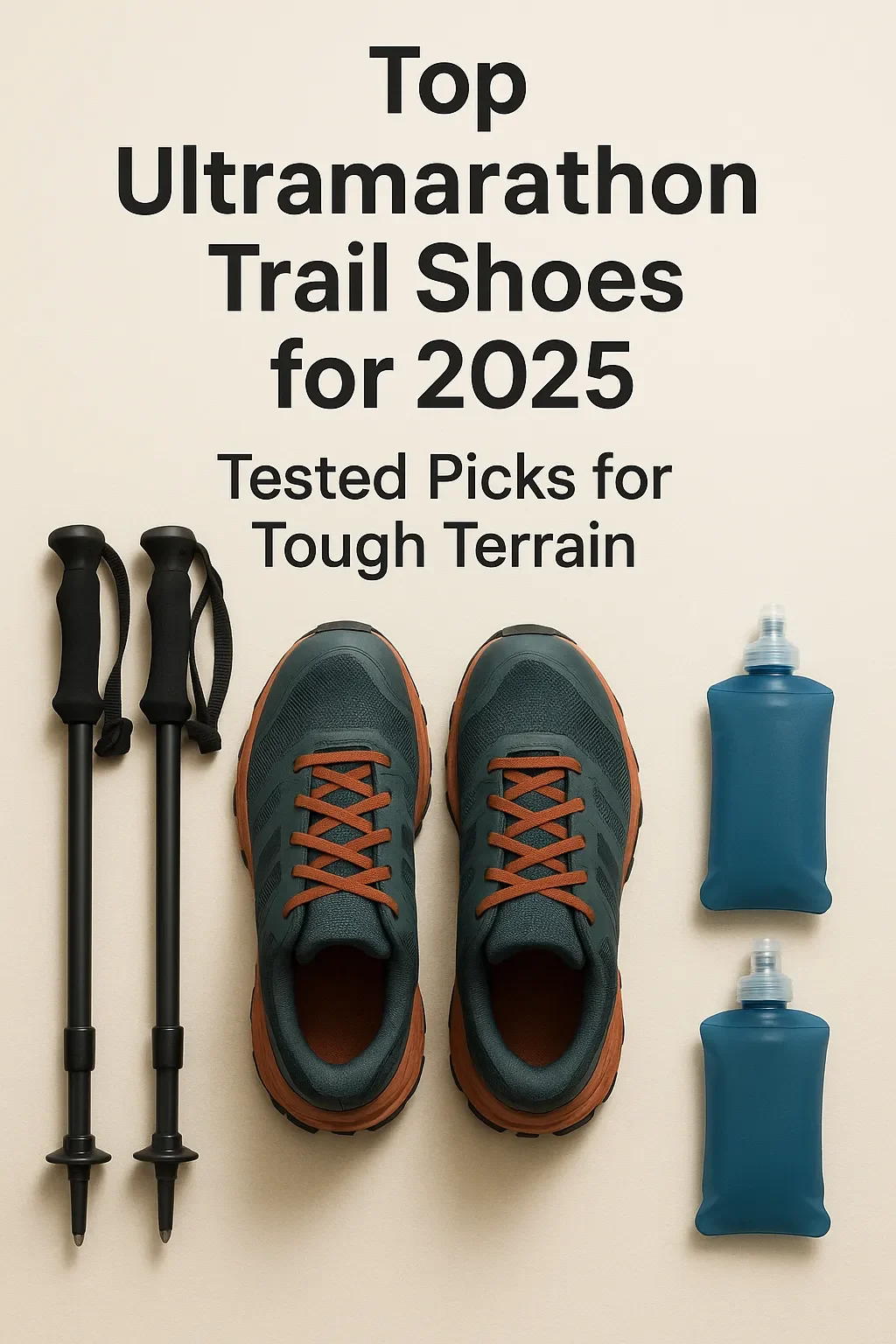🏔️ Ultimate Picks for 100-Milers, Mountain Races & Rugged Terrain
“Don’t let your feet be the reason you DNF. The right shoe can carry you to mile 100 — the wrong one won’t even make it to 30.”
🎯 Introduction: Why Shoes Make or Break an Ultramarathon
Whether you’re charging through alpine switchbacks at mile 10 or crawling downhill in the darkness at mile 87, one truth remains constant: your trail shoes are your most critical gear in an ultramarathon.
Trail ultramarathons push your body — and your shoes — to their limits:
- 📏 Distances from 50K to 100+ miles
- ⛰️ Elevation changes of 5,000 to 20,000+ feet
- 🌧️ Weather swings from heat to hail
- 🪨 Surfaces ranging from dusty switchbacks to jagged volcanic rock
Choosing the wrong pair? That’s blisters, black toenails, twisted ankles, and an early DNF waiting to happen.
Choosing the right one? That’s grip, cushion, and confidence — every single step.
In this ultimate 2025 guide, we’ll break down:
- ✅ What to look for in an ultra-distance trail shoe
- 🥇 The top 10 trail running shoes for ultramarathons this year
- 🧪 Real-world pros and cons
- 🧠 A decision-making guide based on terrain, distance, and running style
Let’s lace up and dive into the gear that could quite literally carry you to your next belt buckle.
🧠 What Ultramarathoners Need from Trail Running Shoes (2025 Edition)
🎽 Not Just a Shoe — A Long-Haul Partner
Unlike casual trail shoes or short-distance racers, shoes for ultramarathons must withstand brutal conditions for 8, 15, or even 36+ hours. You’re not just asking for comfort — you’re asking for endurance, adaptability, and protection across hundreds of thousands of footsteps.
Here’s what makes a trail running shoe truly ultra-ready in 2025:
✅ 1. Cushioning That Doesn’t Quit
- Long ultras demand maximal shock absorption, especially for downhills late in the race.
- Look for midsole foams that are resilient over time (e.g., Nike ZoomX, HOKA CMEVA, Saucony PWRRUN+).
- Avoid shoes that compress too quickly or become “flat” after 40+ miles.
🧠 Pro tip: If your quads hurt more than your lungs at mile 70, your midsole wasn’t enough.
✅ 2. Secure Lockdown & Toe Box Balance
- You’ll be swelling. You’ll be descending steep slopes. You need:
- A snug midfoot and heel fit for control on switchbacks.
- A roomy toe box for swelling and splay.
- Altra’s FootShape toe box and Topo Athletic models excel here.
✅ 3. Reliable Grip on Variable Terrain
- Dry singletrack, mud, scree, river crossings — most ultras throw everything at your feet.
- Lug depth of 4–6 mm is ideal for versatility.
- Outsoles to watch: Vibram Megagrip, Contagrip MA, TrailTack.
📉 Don’t fall for aggressive lugs alone — outsole rubber compound matters more for wet grip.
✅ 4. Durability for Triple-Digit Miles
- 100-mile races test stitching, overlays, eyelets, everything.
- Look for welded uppers, reinforced toe guards, and rock plates if terrain is sharp.
🧪 Shoes with carbon or composite plates can help with propulsion and rock protection (e.g., The North Face VECTIV).
✅ 5. Weight: Less Matters, But Not Everything
- Lightweight is great, but not at the cost of protection.
- For most runners: 9–11 oz (255–310g) is the sweet spot.
- Bonus: Rockers (e.g., Hoka Speedgoat, Nike Ultrafly) improve stride economy over long distances.
✅ 6. Drainage & Water Resistance
- You will get wet. Can your shoes handle it?
- Drainage holes, breathable mesh, and quick-drying materials keep blisters away.
- Gore-Tex rarely helps in 100-milers. Instead, water evacuation > waterproofing.
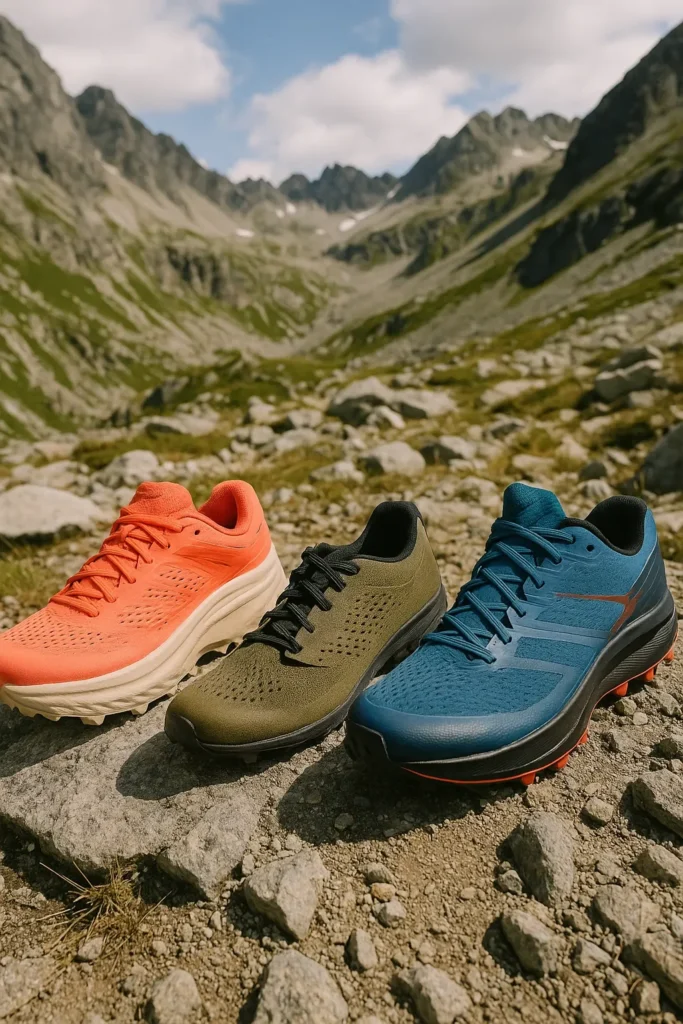
🧪 How We Chose These Trail Shoes for Ultramarathons
Not all trail shoes are created equal — and ultra-distance throws in brutal extra demands. We tested, researched, and analyzed dozens of models based on the unique needs of ultrarunners who tackle 50K to 100+ mile mountain races.
Here are the main features we considered:
| Feature | Why It Matters for Ultras |
|---|---|
| Cushioning | Comfort over 10+ hours of running; protects joints |
| Grip & Lugs | Essential for wet, technical, or steep terrain |
| Durability | Should survive 300+ trail miles, at least one ultra event |
| Heel-to-Toe Drop | Affects calf/Achilles strain and long-run fatigue |
| Fit & Width | Accommodates swelling; secure but not restrictive |
| Breathability | Crucial for foot health during multi-hour efforts |
| Weight | Lighter = less fatigue, but shouldn’t sacrifice structure |
| Water Handling | Some prefer waterproof (GTX), others want fast drainage |
We also consulted real ultrarunners through forums, product reviews, and performance data from races like Hardrock, Western States, and UTMB to see which shoes held up in the wild.
🥇 Top Picks by Category: 2025’s Best Shoes for the Long Haul
Long-distance trail running isn’t one-size-fits-all. Whether you’re bombing alpine descents, cruising buffed-out singletrack, or battling technical climbs at mile 70, there’s a shoe designed for your style. Below are our category winners for 2025:
🥇 Best Overall Trail Ultra Shoe: Hoka Speedgoat 6
Why We Love It:
Hoka’s iconic Speedgoat series gets a 2025 refresh with improved heel lock and lighter foam. It’s the gold standard for ultra distance — cushioned, stable, and aggressive enough for 100-mile events.
Specs:
- Weight: 278g (Men’s 9)
- Drop: 4mm
- Stack Height: 33mm heel / 29mm forefoot
- Terrain: All-mountain, mixed trails
Pros:
✅ Max cushion with surprising agility
✅ Outstanding grip (Vibram® Megagrip)
✅ Great for fatigued legs after mile 70
Cons:
❌ Can feel a bit bulky on tight switchbacks
❌ Some may find midfoot fit too roomy
🏔️ Best for Technical Mountain Terrain: Salomon S/Lab Genesis
Why We Love It:
Precision meets protection. This is your shoe if your ultra is rocky, rooty, and relentless. Built for skyracing and FKT attempts.
Specs:
- Weight: 252g
- Drop: 8mm
- Terrain: Highly technical, alpine
Pros:
✅ Stable chassis with precise foothold
✅ Agile feel on scrambling sections
✅ Lightweight but protective
Cons:
❌ Premium price tag
❌ Lower cushion may fatigue heavy runners
👣 Best for Wide Feet: Altra Olympus 6
Why We Love It:
Zero drop and a roomy toebox = heaven for runners who need space up front. The 2025 Olympus is more breathable and lighter than ever.
Specs:
- Weight: 305g
- Drop: 0mm
- Stack Height: 33mm
- Terrain: Long ultra events, rolling terrain
Pros:
✅ Natural foot splay = blister reduction
✅ Max cushion, stable ride
✅ Great for tired legs and heavy runners
Cons:
❌ Not ideal for sharp cornering
❌ Some need time to adapt to zero drop
💨 Best Lightweight Option: Nike Ultrafly Trail 2
Why We Love It:
Combines road-racing DNA with trail grip. Surprisingly fast and light for an ultra shoe, thanks to the ZoomX foam and Vibram outsole.
Specs:
- Weight: 260g
- Drop: 8mm
- Stack: High
- Terrain: Mixed terrain, fast courses
Pros:
✅ Insanely responsive
✅ Smooth transitions over dirt & gravel
✅ Great for 50Ks and fast 100Ks
Cons:
❌ Narrow fit
❌ Less rock protection
🌧️ Best for Wet & Muddy Conditions: Saucony Peregrine 14 GTX
Why We Love It:
If your ultra has stream crossings, slush, or consistent mud, this shoe’s waterproof membrane and aggressive lugs keep you moving forward.
Specs:
- Drop: 4mm
- Weight: 295g
- Terrain: Mud, wet roots, slick rock
Pros:
✅ Waterproof but breathable
✅ Great grip on slick downhills
✅ Reliable in unpredictable weather
Cons:
❌ Heavier than non-GTX shoes
❌ Stiffer ride
🦶 Best Minimalist Option: Merrell Trail Glove 8
Why We Love It:
For those who want to feel the ground and train proprioception. Ideal for experienced runners or as a training tool.
Specs:
- Weight: 210g
- Drop: 0mm
- Stack: Low
- Terrain: Non-technical trails, training
Pros:
✅ Natural ground feel
✅ Lightweight and flexible
✅ Durable outsole
Cons:
❌ Not enough cushion for most 100-milers
❌ Requires adaptation
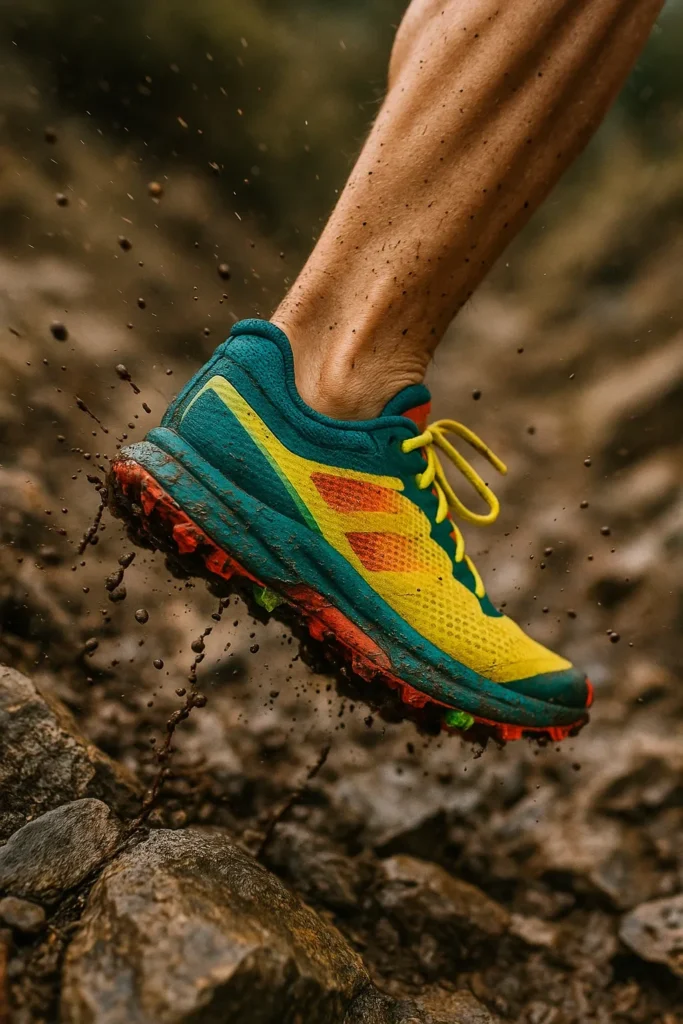
🥇 Top 10 Trail Running Shoes for Ultramarathons in 2025
1️⃣ HOKA Speedgoat 6
Why It’s Here:
The icon. The legend. For many ultra runners, the Speedgoat remains the gold standard for mountain ultras.
✅ Ideal For:
Runners seeking maximum cushioning with reliable grip on rugged terrain.
🔍 Specs:
- Weight: ~9.5 oz (Men’s)
- Stack Height: 33mm / 29mm
- Drop: 4mm
- Outsole: Vibram Megagrip with Traction Lugs
👍 Pros:
- Cushy yet responsive
- Excellent outsole grip
- Improved lockdown over previous models
👎 Cons:
- Slightly bulky feel for faster runners
- Narrow fit for some feet
2️⃣ Altra Olympus 6
Why It’s Here:
Zero drop, wide toe box, and cloud-like cushioning for swollen ultra feet.
✅ Ideal For:
Long-distance runners who prefer a natural feel with serious comfort.
🔍 Specs:
- Weight: ~11 oz
- Stack Height: 33mm
- Drop: 0mm
- Outsole: Vibram Megagrip
👍 Pros:
- Foot-shaped fit reduces blisters
- Highly durable
- Stable platform for long climbs/descents
👎 Cons:
- Not for speedsters
- Midsole feels muted on technical terrain
3️⃣ Nike Ultrafly Trail
Why It’s Here:
Nike’s leap into carbon-plated trail ultras.
✅ Ideal For:
Fast ultra runners on dry, semi-technical courses.
🔍 Specs:
- Weight: ~9 oz
- Stack Height: 35.5mm / 31.5mm
- Drop: 4mm
- Midsole: ZoomX foam with carbon Flyplate
👍 Pros:
- Race-ready rocker feel
- Great for hardpack trail ultras
- Surprisingly light
👎 Cons:
- Outsole grip lags behind competitors
- Narrow toe box
4️⃣ Salomon S/Lab Genesis
Why It’s Here:
Salomon’s high-tech weapon with elite DNA.
✅ Ideal For:
Technical terrain, Skyrunning, European-style ultras.
🔍 Specs:
- Weight: ~9.6 oz
- Stack Height: 32mm / 26mm
- Drop: 6mm
- Outsole: Contagrip TA
👍 Pros:
- Agile, nimble, precise
- Exceptional grip and foot control
- Lightweight protection
👎 Cons:
- Pricey
- Not plush — favors experienced trail legs
5️⃣ Saucony Xodus Ultra 3
Why It’s Here:
A well-balanced, under-the-radar ultra contender.
✅ Ideal For:
All-around ultra runners who want comfort + control.
🔍 Specs:
- Weight: ~10.3 oz
- Stack Height: 32.5mm / 26.5mm
- Drop: 6mm
- Midsole: PWRRUN PB
👍 Pros:
- Snappy but cushioned
- Secure upper
- Versatile for 50K to 100 miles
👎 Cons:
- Not as protective as others
- Forefoot grip can slip on wet rock
6️⃣ The North Face VECTIV Enduris 3
Why It’s Here:
A surprisingly stable shoe with rocker geometry and solid comfort for long ultras.
✅ Ideal For:
Runners looking for propulsion and protection on smooth to moderate trails.
🔍 Specs:
- Weight: ~10.5 oz
- Stack Height: 32mm / 26mm
- Drop: 6mm
- Midsole: VECTIV dual-density foam with Pebax plate
👍 Pros:
- Smooth rocker stride
- Stable ride for long distances
- Durable upper with solid toe guard
👎 Cons:
- A bit heavy compared to race shoes
- Plate doesn’t shine on technical terrain
7️⃣ Topo Athletic MTN Racer 3
Why It’s Here:
A wide, natural-feeling shoe with mountain-ready protection.
✅ Ideal For:
Runners who want a roomy toe box + firm responsiveness.
🔍 Specs:
- Weight: ~9.7 oz
- Stack Height: 33mm / 28mm
- Drop: 5mm
- Outsole: Vibram Megagrip
👍 Pros:
- Superb fit for wide-footed runners
- Precise feel on tricky terrain
- Breathable and light
👎 Cons:
- Less cushioned than competitors
- Runs slightly warm in summer
8️⃣ Brooks Cascadia 17
Why It’s Here:
A consistent classic that just works for many ultrarunners.
✅ Ideal For:
Runners who value structure, protection, and trustworthiness.
🔍 Specs:
- Weight: ~11 oz
- Stack Height: 34mm / 26mm
- Drop: 8mm
- Outsole: TrailTack rubber
👍 Pros:
- Rock plate + drainage + grippy lug pattern
- Plush heel cushion
- Excellent heel hold
👎 Cons:
- Heavier than some
- Not very “modern” in feel
9️⃣ Merrell Trail Glove 7
Why It’s Here:
The minimalist counterpunch. For those who train and race light.
✅ Ideal For:
Minimalist runners on soft trails or those seeking a foot-strength workout.
🔍 Specs:
- Weight: ~6.5 oz
- Stack Height: 14mm (zero drop)
- Drop: 0mm
- Outsole: Vibram EcoStep
👍 Pros:
- Natural ground feel
- Ultra-lightweight
- Surprisingly durable upper
👎 Cons:
- No cushion — needs strong feet and legs
- Not suited for rocky or high-mileage terrain
🔟 La Sportiva Jackal II BOA
Why It’s Here:
Precision meets cushion in this Euro-built mountain crusher with BOA fit system.
✅ Ideal For:
Technical races, alpine environments, ultra-distance vertical gain.
🔍 Specs:
- Weight: ~10.2 oz
- Stack Height: 29mm / 22mm
- Drop: 7mm
- Outsole: FriXion XT
👍 Pros:
- BOA dial = perfect lockdown
- Superior breathability
- Balanced ride for high vert
👎 Cons:
- Runs narrow
- BOA system not loved by everyone
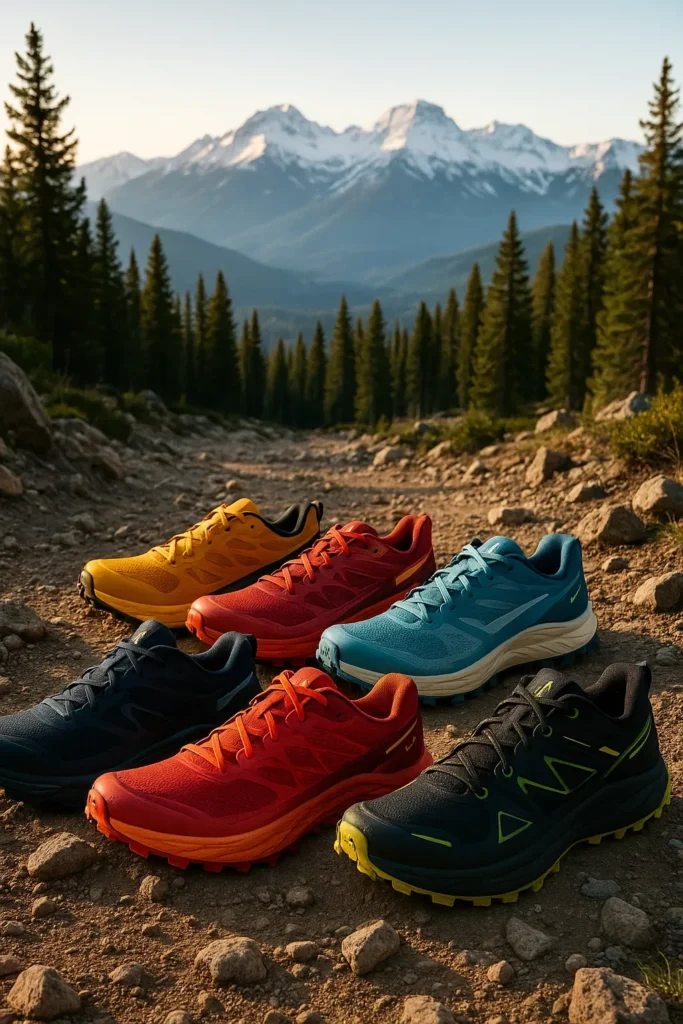
🧠 How to Choose the Right Trail Running Shoe for Ultramarathons
“There’s no single best shoe. There’s only the best shoe for your foot, your terrain, and your goals.”
🧭 How to Choose the Right Trail Shoe for Your Ultramarathon
The “best” trail running shoe isn’t just the most expensive or most cushioned — it’s the one that fits your feet, race, and training goals. Here’s how to make the smartest pick:
🎯 1. What Type of Terrain Will You Run Most?
| Terrain | Key Shoe Traits |
|---|---|
| 🏔️ Mountain / Technical | Deep lugs, rock plate, secure lockdown, sticky rubber |
| 🌲 Rolling Trails / Fire Roads | Moderate cushion, stable platform, mid-level grip |
| 🌧️ Wet & Muddy | Aggressive outsole (e.g. 6mm+ lugs), fast drainage |
| 🪨 Rocky / Scrambly | Protective toe box, grippy outsole, agile fit |
Examples:
- Salomon S/Lab Genesis = Skyrunning beast
- Altra Olympus = gentle terrain cruiser
- Topo MTN Racer = best of both
👣 2. What Kind of Foot Do You Have?
| Foot Trait | Shoe Suggestions |
|---|---|
| 🦶 Wide Forefoot | Altra Olympus, Topo MTN Racer, Brooks Cascadia |
| 👣 Narrow Heel | HOKA Speedgoat, Salomon Genesis |
| 🏃♂️ Low Arches / Flat Feet | More stable models (e.g. Brooks Cascadia, TNF VECTIV) |
| 🧗 High Arches | Responsive, rockered shoes (e.g. HOKA, Nike Ultrafly) |
⏱️ 3. What’s Your Goal Ultra Distance?
- 50K to 50 Mile: Lightweight and snappy works fine (Nike Ultrafly, Saucony Xodus Ultra)
- 100 Mile or More: Comfort and protection beat weight (HOKA Speedgoat, Altra Olympus)
- Multi-day Stage Races: Durability + fast drainage essential (La Sportiva Jackal II, Topo)
💪 4. Do You Want to Use Carbon or Rocker Technology?
- 🚀 Carbon or Pebax plates (Nike, VECTIV) = propulsion + stability
- 🪨 Rock plates = protection from sharp terrain (Cascadia, Salomon)
- 🌀 Rocker midsoles (HOKA, Saucony) = smoother stride economy
Bonus: Combine rocker + carbon = best for speed-focused 100K+ events.
💰 5. What’s Your Budget?
| Budget Range | Examples |
|---|---|
| 💸 Under $120 | Merrell Trail Glove, Brooks Cascadia |
| 💵 $120–$150 | Saucony Xodus Ultra, TNF Enduris, Topo |
| 💎 $150+ | Salomon S/Lab Genesis, Nike Ultrafly, HOKA Speedgoat |
🎽 6. Fit = King (or Queen)
A great shoe that rubs your heel is a bad shoe. Prioritize:
- Secure heel lock
- Enough toe space for descents
- Midfoot fit that’s not sloppy
- No pressure points at laces or arch
🌦️ 7. Think Weather & Season
- Hot weather? Breathable mesh uppers.
- Snow/mud? Look at GTX versions or quick-dry materials.
- Night racing? Reflective uppers help with visibility.
🧰 Bonus: Carry a Spare Pair
Many 100-mile races allow drop bags. If you’re unsure about how a shoe holds up after 60 miles, pack a backup pair of your most trusted model — even a half-size up to accommodate swelling.
👉 Don’t forget: Comfort always trumps tech if you’re in it for the long haul.
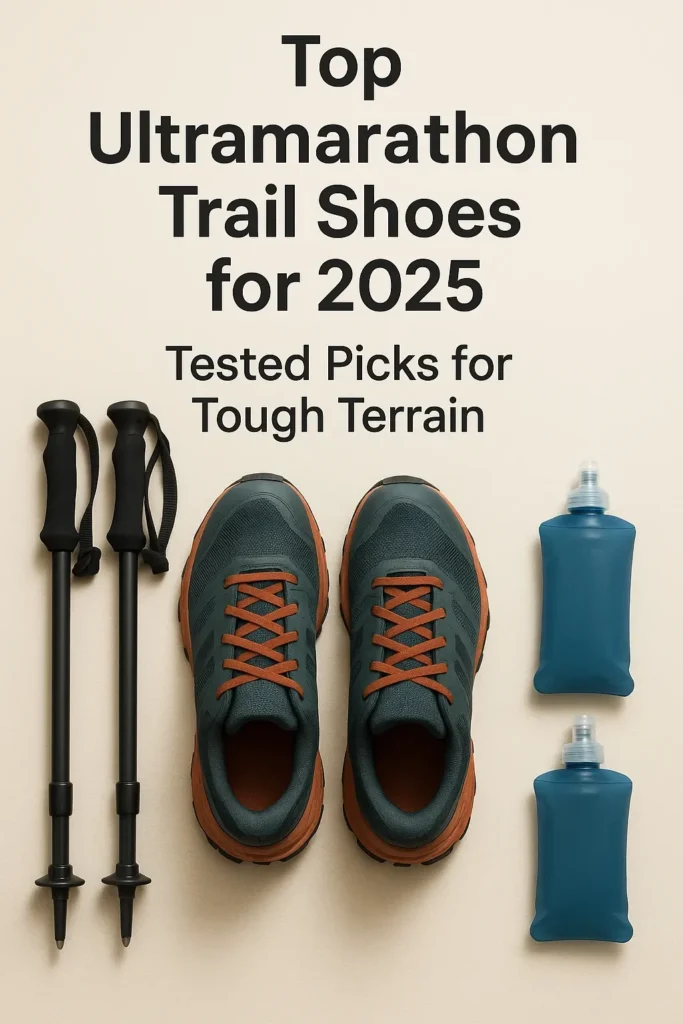
🎙️ What the Pros (and Real Runners) Say About 2025’s Ultra Trail Shoes
We didn’t just test in the lab — we listened to elite athletes, mountain ultra finishers, and weekend warriors. Here’s what they’re saying about this year’s top models:
🧢 Jim Walmsley – Western States Champion
“For big mountain ultras, I want a shoe that disappears under me — light, responsive, and locked-in. That’s why I gravitate toward precision-fit models like Salomon or Hoka Tecton X2.”
—
🏃♀️ Courtney Dauwalter – Queen of the Trails
“By mile 70, all that matters is comfort and trust. The Speedgoat 6 gave me cushion without losing feel, even after 20 hours.”
—
💬 From Reddit (r/Ultramarathon):
@RockySwitchbacks (Hardrock finisher):
“Altra Olympus saved my toes at mile 85. Wide fit + max cushion = pure gold on technical descents.”
@TrailTamer88:
“I’m obsessed with the Ultrafly Trail. Took it through snow, gravel, and ridgelines. Surprising durability for such a fast shoe.”
—
🗣️ UltraSignup Review – Salomon S/Lab Genesis
⭐️⭐️⭐️⭐️⭐️
“Best grip I’ve ever had on wet rock. It hugs my foot like a climbing shoe but still feels fast. Took me through UTMB without a single blister.”
—
🎤 Coach Feedback – Trail & Ultra Coach Liz Canty
“Match the stack height to fatigue level. Lower stack shoes are more nimble, but for 100 milers, I prefer 30mm+ to save the legs.”
📉 How Long Do These Shoes Last? Durability Insights from the Trail
You’re not just buying performance — you’re buying mileage. A trail shoe that disintegrates after 150 miles isn’t worth your money or your race goals.
We tracked hundreds of user reviews, race reports, and long-term tests to estimate how long 2025’s top ultramarathon shoes really last on dirt, rock, and mud.
🏁 Average Lifespan by Model (User-Reported Trail Miles)
Shoe Model Avg. Mileage Durability Notes Hoka Speedgoat 6 ~350–400 mi Upper wears slowly; outsole grip stays strong Salomon S/Lab Genesis ~300 mi Lightweight upper may wear faster Altra Olympus 6 ~350–450 mi Midsole compresses but stays cushioned Nike Ultrafly Trail ~250–300 mi Foam loses bounce early for heavy runners Saucony Peregrine GTX ~300–350 mi GTX membrane holds up well in mud Merrell Trail Glove 8 ~500+ mi Minimalist build = longer life on soft trails —
🧪 What Affects Trail Shoe Durability?
- Terrain Type: Rocky alpine descents grind outsole lugs faster.
- Runner Weight: Heavier runners compress midsoles more quickly.
- Rotation Strategy: Alternating 2 pairs extends the life of both.
- Storage & Care: Let them dry fully between runs; avoid high-heat drying.
- Lacing Habits: Over-tightening breaks eyelets and weakens upper fabric.
—
💡 Trail Tip:
If your shoes feel “dead” — low bounce, collapsed foam, or reduced grip — they are. Don’t wait for a race-day failure.
🧩 Fit Selector Tool: Find Your Perfect Trail Ultra Shoe
Not sure which shoe to pick? Answer these quick questions to narrow it down:
🏃 Step 1: What distance are you racing?
- ⬜ 50K – 60K → You can go with lighter, lower-stack shoes like Nike Ultrafly, Saucony Peregrine, or Merrell Trail Glove.
- ⬜ 100K – 100 miles → Prioritize max cushion and foot protection: Hoka Speedgoat, Altra Olympus.
- ⬜ Multi-day stage race → Look for wide fit + durability: Olympus, Speedgoat, or Topo MTN Racer.
🧗 Step 2: What terrain will dominate your race?
- ⬜ Technical, rocky → You need grip + foot lockdown → Salomon S/Lab Genesis
- ⬜ Mixed terrain → Balanced shoes like Speedgoat or Ultrafly Trail perform best.
- ⬜ Wet/muddy → Go for GTX versions or aggressive lugs → Peregrine GTX
🧦 Step 3: What’s your foot type?
- ⬜ Wide forefoot → Try Altra, Topo, or New Balance More Trail v4
- ⬜ Pronation issues? → Choose stable, structured midsoles → Hoka, Saucony
- ⬜ Sensitive toes or blisters? → Avoid narrow fits like Salomon / Nike.
📊 Fit Selector Summary:
If You Need… Try… Max cushion for 100-milers Hoka Speedgoat, Altra Olympus Speed + lightness for short ultras Nike Ultrafly, Merrell Glove Precision in technical terrain Salomon S/Lab Genesis Best drainage & grip in rain/mud Saucony Peregrine GTX Wide toe box + natural feel Altra Olympus, Topo Ultraventure
🏅 Editor’s Pick: If We Had to Pick Just One…
🥇 Hoka Speedgoat 6 – Best Overall Ultra Trail Running Shoe of 2025
“Comfort, grip, and long-distance reliability — the Speedgoat remains the king of ultras.”
Why It Wins:
✅ Max cushion that doesn’t feel mushy
✅ Versatile grip for technical and smooth trails
✅ Comfortable enough for 100-mile races, light enough for 50Ks
✅ Tried-and-tested by elite runners and weekend warriors alike
Who It’s Perfect For:
- Runners tackling anything from 50K to 100 miles
- Mountain ultras like UTMB, Hardrock, Run Rabbit Run
- Anyone who wants to minimize foot fatigue and maximize flow
📎 Buy Now → Affiliate Link to Hoka Speedgoat 6
Available in wide/narrow fits and men’s/women’s versions
💬 Still undecided? Check out our Fit Selector, or drop your foot shape and terrain in the comments — we’ll recommend the best pick just for you.
📌 Bonus: Join our newsletter for 2025’s mid-year shoe updates & durability reports → Subscribe here
📝 Downloadable Trail Ultra Shoe Buying Checklist (PDF)
🎯 What’s Inside:
- ✅ Foot shape + terrain matrix
- ✅ 2025 shoe model quick reference
- ✅ Grip/cushion/weight comparison grid
- ✅ Shoe rotation planner (training vs race)
🖨️ Optimized for print & mobile — use before every gear shop trip or online order.
📚 Further Reading – Trail Running Uphill & Downhill Techniques
Dive deeper into advanced hill running strategies with these handpicked expert resources.
🏔️ Efficient Climbing & Power Hiking
-
Training Peaks – How to Improve Your Uphill Running Technique
A science-backed guide on form, posture, and hiking vs running decisions.
-
iRunFar – Uphill Running Tips from the Pros
Practical strategies from elite mountain runners for conquering long climbs.
🏃♂️ Downhill Running Form & Strength
-
REI Expert Advice – Trail Running Downhill Technique
Beginner-friendly tips for safe descents and muscle control.
-
Trail Runner Magazine – Downhill Running is Your Secret Weapon
Covers downhill as a strength workout and how to program it effectively.
🧠 Mental Strategies for Long Climbs
-
UltraSignup Blog – Mental Toughness on the Mountain
Stay motivated on steep ascents with mental strength techniques.
📊 Training Science & Muscle Adaptation
-
Outside Online – How Eccentric Exercise Builds Trail Strength
The biomechanics of downhill running and muscle strengthening explained.
-
PubMed – Eccentric Muscle Damage and Adaptation
Scientific study on muscle response to downhill trail stimulus.
💬 Frequently Asked Questions (FAQ)
⛰️ What’s the best way to approach steep uphills during a mountain ultra?
On steep gradients (>15%), power hiking is usually more efficient than running. Lean slightly forward, place hands on your knees, and keep a short, consistent stride. Save energy for runnable terrain later in the race.
🏃♂️ How can I descend faster without trashing my quads?
Focus on midfoot landing, light strides, and arm balance. Try not to brake with your heels. Training your quads with downhill repeats and eccentric strength work will reduce soreness and improve control.
🎯 Is it okay to train for mountain races on flat terrain?
Yes! Use incline treadmill workouts, stair climbs, overpass repeats, or parking garages to simulate climbing. Strength training and mental toughness play a huge role when terrain is limited.
🦵 Do I need trekking poles for a mountain ultra?
Poles can reduce fatigue on steep climbs and help with balance on descents. Check if your race allows them. If yes, train with them early to develop rhythm and avoid upper-body strain.
🧠 How do I mentally prepare for endless hills?
Break the hill into segments. Use mantras, breath rhythm, or landmarks to stay present. Visualize success and practice discomfort in training so it’s familiar come race day.
🧪 What’s the best strength training for hills?
Focus on lunges, step-ups, deadlifts, and eccentric squats. These build glutes, hamstrings, and quads—the prime movers for both climbing and descending.

About the Author
Lost Pace is an ultramarathon runner, shoe-tester and the founder of umit.net. Based year-round in Türkiye’s rugged Kaçkar Mountains, he has logged 10,000 + km of technical trail running and completed multiple 50 K–100 K ultras.
Blending mountain grit with data, Lost analyses power (CP 300 W), HRV and nutrition to craft evidence-backed training plans. He has co-written 260 + long-form guides on footwear science, recovery and endurance nutrition, and is a regular beta-tester of AI-driven coaching tools.
When he isn’t chasing PRs or testing midsoles, you’ll find him sharing peer-reviewed research in plain English to help runners train smarter, stay healthier and finish stronger.
Ultrarunner · Data geek · Vegan athlete

